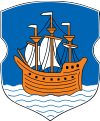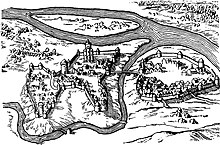Polatsk
| Polatsk | Polotsk | |||
| Полацк | Полоцк | |||
| ( Belarus. ) | ( Russian ) | |||
|
|||
| State : |
|
||
| Woblasz : |
|
||
| Coordinates : | 55 ° 29 ′ N , 28 ° 48 ′ E | ||
| Height : | 231 m | ||
| Area : | 36.74 km² | ||
| Residents : | 84,597 (2018) | ||
| Population density : | 2,303 inhabitants per km² | ||
| Time zone : | Moscow time ( UTC + 3 ) | ||
| Telephone code : | (+375) 214 | ||
| Postal code : | BY - 211291, 211400 - 211402, 211404 - 211415, 211422 | ||
| License plate : | 2 | ||
| Website : | |||
|
|
|||
Polazk or Polotsk ( Belarusian Полацк / Polazk or Полацак / Polazak , Russian Полоцк / Polotsk , Polish Połock , German Plotzkow ) is the oldest city in Belarus . It is located in the north of the country on the Daugava River in Vitebskaya Woblasz and is the capital of Polatsk district . In 2018 the city had 84,597 inhabitants. In the early Middle Ages, Polatsk was the center of the Principality of Polatsk , which was one of three principalities on Belarusian territory that emerged from the Kievan Rus and are regarded by today's Belarus as the forerunner states. To the west of Polatsk lies the large satellite town of Navapolatsk .
history
The old East Slavic name Polotesk is derived from the Polota river , which flows into the Daugava near the city. The Vikings corrupted the name to Palteskja or Paltejsborg.
Polatsk is one of the oldest cities in ancient Russia . It is mentioned as early as 862 along with Murom and Beloozero . The Nordic legends describe it as the best fortified city in all of Russia.
Between the 10th and 12th centuries, the Principality of Polatsk developed into the most important center of power on Belarusian territory, alongside the less important Turau in the south. Several times it defended its independence from other centers of the Kievan Rus and became the political capital and bishopric. From here the Baltic subject countries in the west were controlled. The most powerful ruler was Prince Vseslav Brjachislavich (1044 to 1101).
Since 1307 Polatsk was part of the Grand Duchy of Lithuania and an important trading center. In 1498 the city was granted Magdeburg law . With the administrative reform at the beginning of the 16th century, a Polatsk Voivodeship was founded. Stefan Batory established a Jesuit college here , the first rector of which was Piotr Skarga . Ivan the Terrible captured Polatsk in 1563, but had to return it 16 years later. With this conquest, however, the city began to decline; after the first partition of Poland it sank into a provincial nest of the Russian Empire .
During Napoleon's Russian campaign, the First Battle of Polotsk between Russian troops and Napoleon's Bavarian allies took place here in 1812 . The Bavarian army was able to maintain the field and repel the Russian attack, which was aimed at the flank of the French advance. The Bavarian contingent of the Grande Armée suffered heavy losses. The Bavarian generals Erasmus von Deroy and Justus von Siebein died in the fighting. In the Second Battle of Polotsk , which took place from October 18 to 20, 1812, the Russian army was victorious and was then able to endanger and hinder supplies to the Grande Armée .
Polotsk was in World War II when German invasion of the Soviet Union from the June 30, 1941 Wehrmacht conquered. At that time, about 45,000 people lived in the city, about 60% of whom were Belarusian Jews. Many were murdered in the Holocaust . Only 551 Polatsk Jews lived in the city after the end of the war. In the summer of 1944, over 90% of the city was destroyed by the fighting during Operation Bagration . On July 6, 1944, Polatsk was liberated by the Red Army after days of fighting . After the war, the city was rebuilt by the surviving residents.
coat of arms
Description: In blue a three-masted golden cog with two billowing white square sails and three mast flags over a silver wave shield base .
Culture
The Sophia Cathedral (1044-1066), which had its parallels in the Sophia Cathedrals of Kiev and Novgorod (and ultimately in the Hagia Sophia of Constantinople ), underlines the lordship claims of the princes of Polatsk. However, the medieval building was replaced by a baroque church in the 18th century based on a design by the architect Johann Christoph Glaubitz, who was also working in Vilnius at the same time . The St. Euphrosyne Monastery still contains components from the 12th century, but also a large neo-Byzantine cathedral by the architect Konstantin Thon . The Jesuit Church and the Roman Catholic St. Nicholas Cathedral also formerly existed in Polatsk.
The city is home to the historical and cultural museum complex, to which the following museums belong: The Polatsk Museum of Regional Studies, the Museum of Book Printing, the Simeon Polatski Library , the Museum of Traditional Weaving Art of the Paazerje Region, the Museum of War Glory , the Museum of the Architectural History of St. Sophia Cathedral, the Children's Museum, the House of Peter I, the exhibition “Прагулка па Ніжнепакроўскай” (a walk across Nižnekaproŭskaja , the former main street in the historic city center, now known as Lenin Street ) and the art gallery.
In 2003 the Janka-Kupala-Theater Minsk opened a branch in Polatsk.
In the 12th century in Polotsk had the nun and writer Euphrosyne of Polotsk ( Преподобная Евфросиния Полоцкая , white russ .: Ефрасіння Полацкая ) (1110-1173), who built the monasteries, books translated and promoted literature and art (such as the force as a national relic “Euphrosyn cross” by the Polatsk craftsman Lazarus Bohscha, which was lost in World War II , and the Church Slavonic sermons and writings of Bishop Kyrill von Turau , 1130–1182). She died on a pilgrimage to Jerusalem . Her bones were initially kept in the Kiev Pechersk Lavra ( Киево-Печерский монастырь ), but in 1910 they were transferred to Polatsk. Euphrosyne von Polatsk is considered the patron saint of the Belarusians.
The first printer in Belarus, Francysk Skaryna , was born in Polatsk around 1490. In 1517 he printed the first Bible in the East Slavic language (in Old Ruthenian ), only a few decades after Gutenberg's Bible printing and a few years after the first Czech Bible (1506). Skaryna had a lasting influence on the further development of the Belarusian language with his achievements as a book printer, but also with his translations of the Bible into a form of Old Belarusian and is now considered a national figure of identification in Belarus .
In September 2003, during the 10th “Days of Belarusian Literature”, a memorial was unveiled for the Belarusian letter Ў , which does not appear in any other Cyrillic alphabet.
education and Science
The historical-philological faculty of the Polotsk State University is located in Polatsk. All other facilities of the university are located in Navapolatsk.
sons and daughters of the town
- Mary Antin (1881–1949), author of The Promised Land
- Uladsimir Arlou (* 1953), historian and poet
- Georg Barkan (1889–1945), pharmacologist
- Salomon Bennet (1767–1841), engraver
- Euphrosyne von Polatsk (1110–1173), patron saint of the Belarusians
- Boris Galjorkin (1871–1945), engineer and mathematician
- Dmitri Kaigorodow (1846–1924), Russian forest scientist, ornithologist and university professor
- Natallja Katschanawa (* 1960), politician
- Symeon von Polatsk (1629–1680), writer of the Belarusians
- Ihar Schytau (* 1986), football player
- Francysk Skaryna (1486–1541), first printer in Belarus
various
A crater on Mars is called Polotsk .
Twin cities
-
 Jarolsav (Poland)
Jarolsav (Poland)
-
 Gdansk (Poland)
Gdansk (Poland)
-
 Elektrostal (Russia)
Elektrostal (Russia)
-
 Tosno (Russia)
Tosno (Russia)
-
 Suoyarvi (Russia)
Suoyarvi (Russia)
-
 Kansk (Russia)
Kansk (Russia)
-
 Veliky Novgorod (Russia)
Veliky Novgorod (Russia)
-
 Velikie Luki (Russia)
Velikie Luki (Russia)
-
 Alaverdi (Armenia)
Alaverdi (Armenia)
-
 Trakai (Lithuanians)
Trakai (Lithuanians)
-
 Jonava (Lithuanians)
Jonava (Lithuanians)
-
 Obukhov (Ukraine)
Obukhov (Ukraine)
-
 Kamianets-Podilskyj (Ukraine)
Kamianets-Podilskyj (Ukraine)
-
 Friedrichshafen (Germany) / since 1990
Friedrichshafen (Germany) / since 1990
literature
Rotraut and Jürgen Binder: "POLOZK - Is there a primeval forest there?" A reader on the partnership with the Belarusian city of Polotsk. Verlag Robert Gessler, ISBN 3-86136-139-6
- Polotsk , in: Guy Miron (Ed.): The Yad Vashem encyclopedia of the ghettos during the Holocaust . Jerusalem: Yad Vashem, 2009 ISBN 978-965-308-345-5 , p. 609
See also
History of Belarus , Golden Age (Belarus)
Web links
- Polacak
- Photos on Radzima.org
- ePOLOTSK.com
- Polotsk
- The KB 5th Infantry Regiment in the Battle of Polotsk
Individual evidence
- ↑ National Statistical Committee of the Republic of Belarus: Численность населения на 1 января 2018 г. и среднегодовая численность населения за 2017 год по Республике Беларусь в разрезе областей, районов, городов и поселков городского типа (population on 1 January 2018 and average population in 2017 for the Republic of Belarus after oblasts, Rajonen, towns and settlements of urban type) accessed on February 10, 2020.
- ↑ Archived copy ( memento of the original dated August 31, 2018 in the Internet Archive ) Info: The archive link was inserted automatically and has not yet been checked. Please check the original and archive link according to the instructions and then remove this notice. Homepage of the Friedrichshafen Partnership Association
- ↑ https://www.friedrichshafen.de/buerger-stadt/stadtportraet/partnerstaedte-freundschaften/ official homepage of the city of Friedrichshafen




